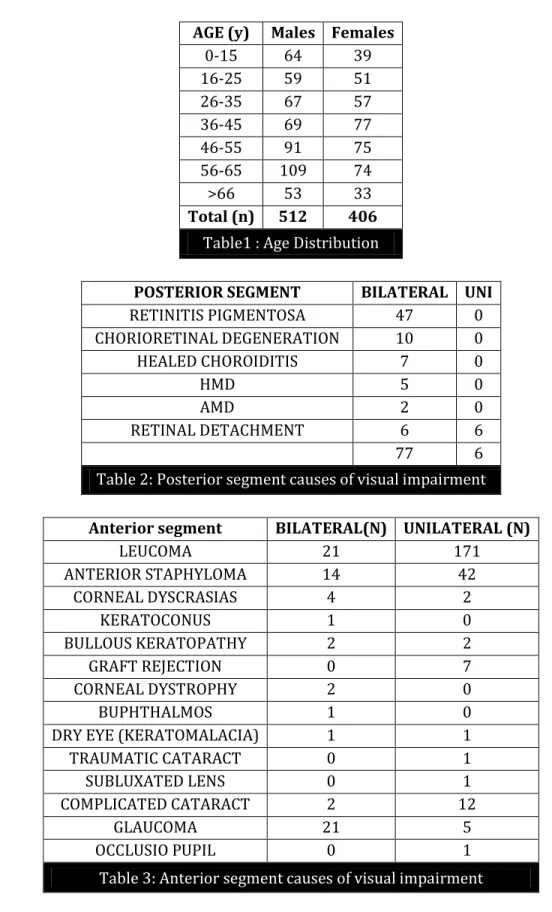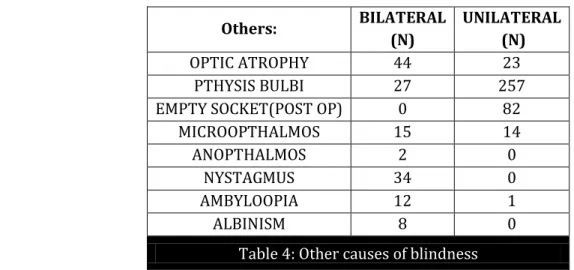DOI: 10.14260/jemds/2015/458
ORIGINAL ARTICLE
J of Evolution of Med and Dent Sci/ eISSN- 2278-4802, pISSN- 2278-4748/ Vol. 4/ Issue 18/ March 02, 2015 Page 3169
CAUSES OF BLINDNESS IN A TERTIARY REGIONAL EYE CARE CENTER IN
SOUTH INDIA
K. Revathy1, B. Yugandhar2, G. Narendranath Reddy3
HOW TO CITE THIS ARTICLE:
K. Revathy, B. Yugandhar, G. Narendranath Reddy Causes of Blindness in a Tertiary Regional Eye Care Center in South India. Journal of Evolution of Medical and Dental Sciences 2015; Vol. 4, Issue 18, March 02; Page: 3169-3172, DOI: 10.14260/jemds/2015/458
ABSTRACT: Blindness and visual impairment is an important public health problem worldwide. The numbers of blind people in India are 12 million, with the estimated increase to 15 million expected by 2020.1 This is a retrospective study done to enumerate the causes of blindness among people
attending a regional tertiary care center for visual disability certificate program over a period of one year. Most common cause of blindness was phthisis bulbi and is also the most common cause of unilateral loss of vision. The second most common cause is leucoma. Most of the studies done till date found cataract as the most common cause of blindness in India. In this study most of the avoidable causes such as cataract and refractive errors were not noted but there were a high number of cases of visual impairment due to leucoma accounting for 20.91% of cases, most of them due to trauma indicating the need for educating primary care providers regarding the early identification and treatment of ocular injuries and prompt referral to an ophthalmologist in the rural areas.
KEYWORDS: Blindness, leucoma, south India
.
INTRODUCTION: Blindness and visual impairment is an important public health problem worldwide. About 285 million people are visually impaired of who nearly 39 million are blind and 246 million have low vision. 90% of the world’s visually impaired people live in developing countries. The number of blind people in India are 12 million, with the estimated increase to 15 million expected by 2020, and additional 52 million visually impaired.1,2
METHODS: This is a retrospective study done to enumerate the causes of blindness among people attending a regional tertiary care center for visual disability certificate program over a period of one year. 918 subjects attended the outpatient department (OPD) over a period of one year with the complaint of loss of vision and were evaluated for the extent and cause of blindness. Blindness was defined according to WHO as vision < 3/60 in the better eye in patients with bilateral causes of blindness, while in patients with unilateral cause of loss of vision all the patients had vision of <3/60 in the affected eye.
DOI: 10.14260/jemds/2015/458
ORIGINAL ARTICLE
J of Evolution of Med and Dent Sci/ eISSN- 2278-4802, pISSN- 2278-4748/ Vol. 4/ Issue 18/ March 02, 2015 Page 3170 lesions accounting for 61.5% (n=192) of the cases. The single most common cause of bilateral loss of vision was Retinitis pigmentosa accounting for 5.1% (n=47) of all cases.
AGE (y) Males Females 0-15 64 39 16-25 59 51 26-35 67 57 36-45 69 77 46-55 91 75 56-65 109 74 >66 53 33 Total (n) 512 406
Table1 : Age Distribution
Anterior segment BILATERAL(N) UNILATERAL (N)
LEUCOMA 21 171
ANTERIOR STAPHYLOMA 14 42
CORNEAL DYSCRASIAS 4 2
KERATOCONUS 1 0
BULLOUS KERATOPATHY 2 2
GRAFT REJECTION 0 7
CORNEAL DYSTROPHY 2 0
BUPHTHALMOS 1 0
DRY EYE (KERATOMALACIA) 1 1
TRAUMATIC CATARACT 0 1
SUBLUXATED LENS 0 1
COMPLICATED CATARACT 2 12
GLAUCOMA 21 5
OCCLUSIO PUPIL 0 1
Table 3: Anterior segment causes of visual impairment
POSTERIOR SEGMENT BILATERAL UNI
RETINITIS PIGMENTOSA 47 0 CHORIORETINAL DEGENERATION 10 0
HEALED CHOROIDITIS 7 0
HMD 5 0
AMD 2 0
RETINAL DETACHMENT 6 6
77 6
DOI: 10.14260/jemds/2015/458
ORIGINAL ARTICLE
J of Evolution of Med and Dent Sci/ eISSN- 2278-4802, pISSN- 2278-4748/ Vol. 4/ Issue 18/ March 02, 2015 Page 3171
Others: BILATERAL
(N)
UNILATERAL (N)
OPTIC ATROPHY 44 23
PTHYSIS BULBI 27 257
EMPTY SOCKET(POST OP) 0 82
MICROOPTHALMOS 15 14
ANOPTHALMOS 2 0
NYSTAGMUS 34 0
AMBYLOOPIA 12 1
ALBINISM 8 0
Table 4: Other causes of blindness
DISCUSSION: Global prevalence of blindness has decreased from 45 million blind persons in 2000 to 39 million in 2010. This decreased trend of prevalence was also reflected in India.3 The World Health
Organization report shows a significant reduction in the number of the blind persons in India from 18.7 million in 2000 to 12 million in 2010 but with the estimated increase to 15 million expected by 2020, and additional 52 million visually impaired. With the launch of Vision 2020 global initiative, the focus has shifted to all causes of avoidable blindness rather than being limited to cataract and rapid assessment done to include all causes of avoidable blindness.4,5,6 In this study we have taken as a
study group patients who have visual impairment unilaterally or bilaterally and seeking a visual disability certificate, most of them untreated and some with congenital causes of blindness. Most of the studies done till date found cataract as the most common cause of blindness in India,7 but they
were population based or included patients who were seeking treatment. In this study most of the avoidable causes such as cataract and refractive errors were not noted, as the focus on cataract has led to awareness in rural communities with people seeking treatment.3,8 But there were a high
number of cases of visual impairment due to leucoma accounting for 20.91% of cases, most of them due to trauma indicating the need for educating primary care providers regarding the early identification9 and treatment of ocular injuries and prompt referral to an ophthalmologist in the rural
areas.
REFERENCES:
1. Blindness and Visual Impairment: Global Estimates of Visual Impairment 2010. International Agency for the Prevention of Blindness: Vision-2020.
2. India: A Vision 2020 Handbook on Equipping a Secondary Eye Hospital. January 20, 2010. 3. Kupfer H, Polack S, Limburg H (2006) Rapid assessment of avoidable blindness. Community Eye
Health 19: 68-9.
4. VISION 2020 the Right to Sight - Plan of Action NPCB, India Ophthalmology / Blindness Control Section, Govt. of India.
5. Vision 2020: The Right to Sight: Global Initiative for the Elimination of Avoidable Blindness: Action Plan 2006-2011.
6. Working together to eliminate avoidable blindness: Vision 2020: Action Plan 2006-2011. 7. Siraj R, Nirmalan R, Blindness and visual impairment in a Rural South Indian Population. The
DOI: 10.14260/jemds/2015/458
ORIGINAL ARTICLE
J of Evolution of Med and Dent Sci/ eISSN- 2278-4802, pISSN- 2278-4748/ Vol. 4/ Issue 18/ March 02, 2015 Page 3172 8. Khanna Rohit C, Marmamula Srinivas, Krishnaiah sannapaneni, Pyda Giridhar, Chakrabarti
Subhabrata, and Rao Gullapalli N. Changing trends in the prevalence of blindness and visual impairment in a rural district of India: Systematic observations over a decade. Indian J ophthalmol. 2012 Sep-Oct; 60(5): 492-497.
9. Bhattacharjee, H., Das, K., Borah, R. R., Guha, K., Gogate, P., Purukayastha, S., & Gilbert, C. (2008). Causes of childhood blindness in the northeastern states of India. Indian Journal of Ophthalmology, 56(6), 495–499.
AUTHORS:
1. K. Revathy 2. B. Yugandhar
3. G. Narendranath Reddy
PARTICULARS OF CONTRIBUTORS:
1. Associate Professor, Department of Ophthalmology, Kurnool Medical College. 2. Civil Assistant Surgeon, Department of
Ophthalmology, Kurnool Medical College. 3. Professor, Department of Ophthalmology,
Kurnool Medical College.
FINANCIAL OR OTHER
COMPETING INTERESTS: None
NAME ADDRESS EMAIL ID OF THE CORRESPONDING AUTHOR:
Dr. K. Revathy, H. No. 3/6/80-A, W/O. Dr. T. Dhanaraju, Krishna Nagar, Kurnool, Andhra Pradesh-518002.
E-mail: revathydhanaraju@gmail.com

